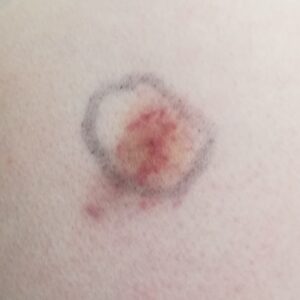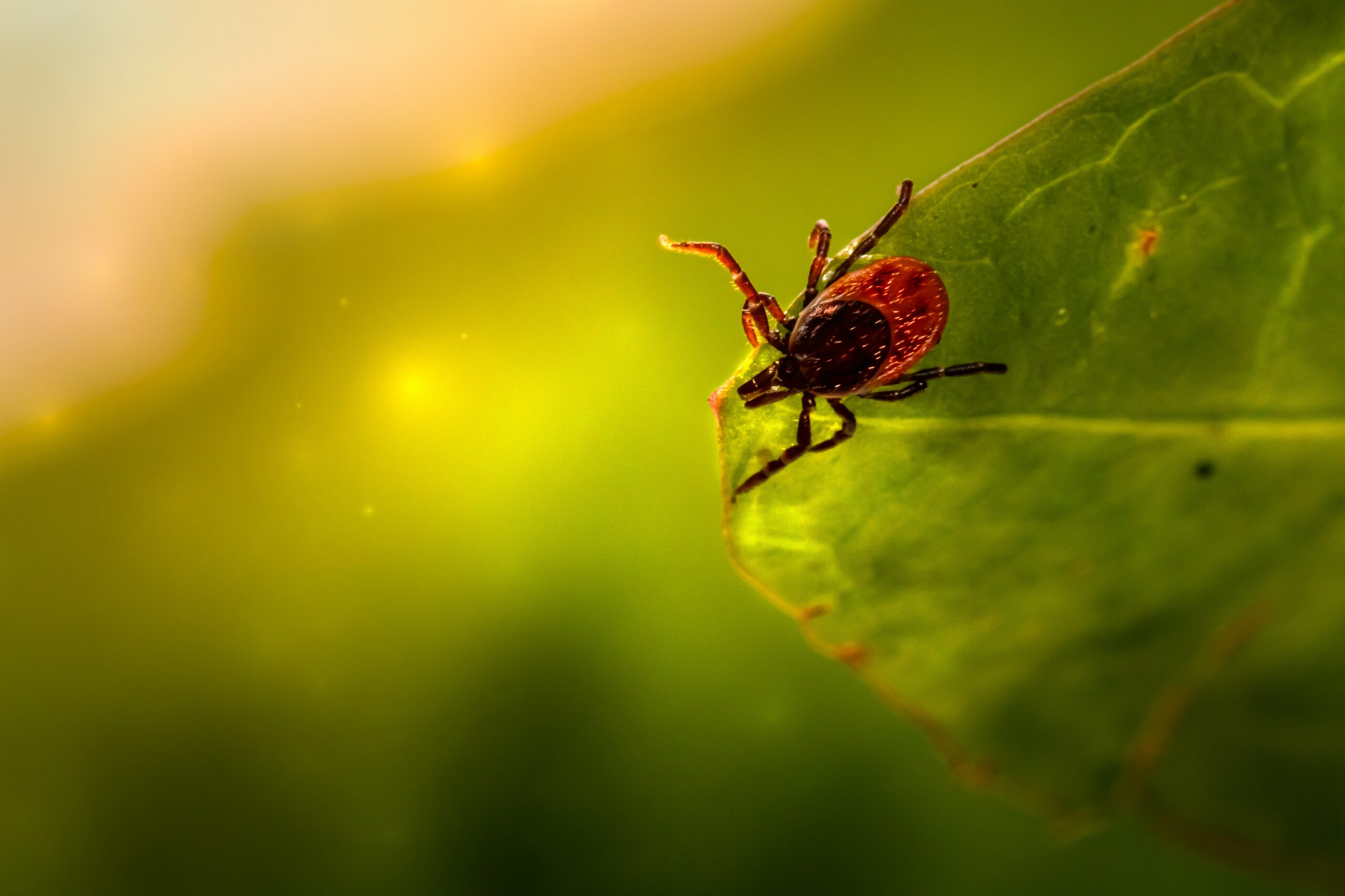Risks of Tick Bites
What is a tick?
Ticks are small arachnids that can pose potential health risks to humans. They have a life cycle that includes three stages: larva, nymph and adult. Ticks are blood-sucking parasites that feed on the blood of animals and humans, which can lead to serious health problems in humans. They can be found all over the world and vary in difficulty to detect and remove.
Which is correct: tick bite or tick bite?
The term “tick bite” is a common misnomer, the most accurate term in this case is “tick bite”. Ticks feed on the blood of their host and bite the skin with a long, nose-like process, the proboscis.
In the German vernacular, however, the wrong term “tick bite” has become commonplace. From the point of view of those affected, this distinction is of course irrelevant. Because today almost everyone knows what is meant by tick bite or tick bite.
What are the risks of a tick bite?
The most common symptoms of tick bites are redness, rash, fever, chills, headache, fatigue and muscle aches. Other symptoms include headaches, joint pain, and vomiting. Ticks transmit diseases such as Lyme disease and tick-borne encephalitis or tick-borne encephalitis (TBE).
Ticks should be removed from the skin as soon as possible to reduce the risk of infection. The longer the tick sucks blood, the higher the risk of bacteria or viruses entering the host’s body from it.
Habitat of Ticks
Ticks are a type of arachnids that live mainly in humid areas. They are most often found in forests, meadows and other outdoor areas. Ticks feed on the blood of their hosts, waiting for them on grasses and other plants.
If a person or animal roams through the vegetation and encounters a tick, the tick gets caught in the hair or clothing. So, in most cases, it does not actively search for a host, but waits until a host comes by.
Finally, when a tick is on the body of its victim, it continues to climb to a suitable place where the skin is thin and blood vessels are close to the surface. There she feeds on the blood of her victim for several days.
Do ticks live on trees?
There is a rumor that ticks jump from the trees to their hosts in the forest. On the other hand, ticks are very small arachnids that have no thread and travel long distances only as a stowaway of their hosts. A tick is unlikely to climb a large tree in order to actively fall on animals and people.
But forests are also home to ticks. In the forest, ticks lurk in the undergrowth and grass for wildlife such as deer, foxes and martens. Humans are more of an accidental bycatch for ticks, because if a tick is discovered in a dog or human, it is usually their death.
Tick diseases briefly explained: Lyme disease and TBE
Lyme disease is an infection caused by a bacterium called Borrelia burgdorferi. Tick bites are the main route of infection of this disease for humans.
Lyme disease can be treated with antibiotics. For the success of the treatment, it is crucial to treat as early as possible and to ensure that the dosage and duration of therapy are sufficient. If Lyme disease is not detected and treated early, the chances of success decrease considerably, as the bacteria settle deep in the body (e.g. in joints) and are difficult for oral antibiotics to reach. In this case, the only option is usually to administer intravenous antibiotics in the hospital for a period of at least 10 days.
Tick-borne encephalitis (TBE) is a virus that can be transmitted to humans by ticks, especially by the tick species Ixodes ricinus, which is also known as sheep ticks, deer ticks or common wood tick. The virus can also be transmitted from person to person, but this is rare and usually occurs through contact with body fluids, i.e. close physical contact.
The name TBE refers to the tick season, early summer, as well as to the disease, a meningitis that can lead to severe disability and death. Only some of those infected develop encephalitis. Many sufferers have no or only flu-like symptoms. Anyone who regularly spends time outdoors in risk areas can be vaccinated against TBE (the so-called “tick vaccination”).
Tick repellent: Prevent being bitten by ticks
It is important to know that ticks can be found not only in wooded areas, but also near your home or in your garden. It can be difficult to protect yourself against tick bites, but some practical strategies include using insect repellent and checking for ticks regularly.
To prevent tick bites, it is recommended to wear long-sleeved and light-colored clothing when you go outside. In this way, the small animals can be recognized before they sting and can transmit diseases.
You can also use insect repellent on your clothes and skin. There are various chemical tick remedies, as a rule, these are neurotoxins. Other tick repellents are based on essential oils.
After spending time outdoors, you should check your clothes and skin for ticks. Especially for people who spend a lot of time outdoors, such as forestry workers, gardeners, garden owners, dog owners or children living in rural areas, the topic of ticks and tick diseases should be discussed often and precautions should be taken.
Scan the body for ticks
It is important to thoroughly examine your body when you have been outside in nature. You should start with your hairline and work your way up from there, i.e. from the top of the body to the bottom.
Children should be searched by parents or trusted persons, as they still find it difficult to search their bodies systematically.
Skin folds and hidden regions, even in the genital area, are also visited by ticks. Parts of the body that are difficult to see can be palpated by hand, because sucking ticks are easily felt as foreign bodies.
It is important not to scratch or crush a tick. Each tick must be removed alive to reduce the risk of infection.
How to remove a tick correctly?
The best way to remove a tick is to use a tool that does not break off the tick’s head, such as tweezers or a tick removal card. They hold the tick directly at the puncture site and, if necessary, squeeze the suction apparatus, which prevents reflux of infected stomach contents of the tick.
Often it is reported that a tick should be removed with a twist. However, since ticks do not have a thread, this advice should be taken with a grain of salt. Instead, you should be careful not to crush the tick and pull it out quickly (but not jerkily!) and as vertically as possible. To relieve pain when removing a tick, the second hand of the patient, helper or doctor can tighten the skin at the puncture site.
If you do not dare to remove a tick yourself, then a doctor can be consulted. This can remove the tick completely and start further therapy. As a rule, the specialist staff of the doctor’s office can also provide initial care and remove the tick to prevent further delay.
How to treat a tick bite

After the tick is pulled, the wound can usually be treated with disinfection and a plaster. Before that, one should be sure that no parts of the tick have remained in the wound. Marking the puncture site with a waterproof pen makes it easier to diagnose later in the event of inflammation or redness. (“Wandering Redness”)
Occasionally it happens that the sting of the tick breaks off and is still completely or partially stuck in the wound. In this case, a doctor should be consulted, otherwise there is a threat of inflammation.
Superficial disinfection and wound dressing do not prevent the risk of tick infection with Borrelia or TBE, because the pathogens enter deep into the wound through the tick’s sting and are already distributed in the area of the puncture at this time.
How to recognize an infection from a tick bite?
The most common symptom of a tick bite is redness at the site of the bite. Other signs of infection include fever, headache, fatigue, and muscle aches. The signs of the disease can occur with Lyme disease and TBE.
The redness on the tick bite can occur after a longer period of time (sometimes several days or even weeks). Particularly characteristic is the so-called migratory redness, an expanding, circular redness that fades inwards (towards the puncture site). If such a red ring occurs on the body, the suspicion of a tick bite, possibly unnoticed, should immediately arise and an antibiotic should be started.
So, if you have been bitten by a tick and notice the symptoms listed above, it is important to immediately consult a doctor so that he can assess the situation and, if necessary, start therapy.
Home remedies for ticks
There are some home remedies that help detect ticks faster. If you are out in the great outdoors, you can wear light-colored clothing and put on long pants and sleeves. As a result, ticks are already noticeable on clothing.
You should also be careful not to suffocate or crush the tick. Home remedies such as glue or chemicals to pull the tick more easily should be avoided at all costs, because the tick will suffocate and vomit into the wound, which greatly increases the risk of infection.
A simple home remedy for ticks is essential oils. Even over-the-counter tick repellents often contain a colorful mix of essential plant extracts, primarily terpenes, aldehydes and phenols, which are effective against many parasites. In addition to ticks, such remedies are also effective against mosquitoes, for example. This passive protection can be applied specifically to clothing, arms and legs to deter ticks.
Conclusion: Avoid, detect and treat tick bites quickly
Let’s summarize some key findings of this article:
- Tick bites can hardly be avoided, regularly check the body for ticks, show the inflamed tick bite to the family doctor
- Ticks are parasites that are transmitted from animals to humans. They can cause diseases such as Lyme disease, lesser-known tularemia (rodent plague) or meningitis, which occurs in severe cases of TBE.
- Tick bites are almost impossible to avoid, as ticks are native to our nature. Particularly at risk are people and animals, who are often out and about in the wild. These include gardeners, forestry workers, farmers, rural children, dogs and dog owners. You can protect yourself with tick repellents, clothing and regular searching.
- In order to avoid tick bites, it is important that you regularly check your body for ticks and show inflamed bites immediately to your family doctor. With early antibiotic therapy, the risk of late complications of Lyme disease is low. It also helps the doctor, if he is informed about a tick find, to correctly interpret the often confused and flu-like symptoms of a tick disease.
- TBE is a viral disease that can only occasionally lead to severe encephalitis with meningeal involvement. It is treated symptomatically with painkillers and bed rest. As a rule, the patient’s immune system does the rest.
- Tick vaccination is recommended before travel and activities in high-risk areas. This must be refreshed regularly.
